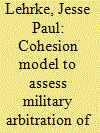| Srl | Item |
| 1 |
ID:
127814


|
|
|
|
|
| Publication |
2014.
|
| Summary/Abstract |
The purpose of this article is to outline a model of cohesion useful for assessing military arbitration of revolutions. Current approaches to the study of revolution are not able to adequately integrate the military into their analysis. To remedy the lack of appropriate tools, this article outlines a model of cohesion that may be useful for conceptualizing and examining the behavior of military forces during domestic political crises. Building on the so-called standard model of cohesion, the article develops a cohesion-coordinated action model that incorporates a structural social cohesion element and a voluntarist-coordinated action element, both of which also capture the relations and interactions between the military, the regime, and the opposition. It thereby fulfils the requirements that a model must possess but where other approaches fall short. The article concludes by outlining how this model can be used in further research in order to advance the study of the military's role in revolutions.
|
|
|
|
|
|
|
|
|
|
|
|
|
|
|
|
| 2 |
ID:
088941


|
|
|
|
|
| Publication |
2009.
|
| Summary/Abstract |
Anthony King's "The Word of Command: Communication and Cohesion in the Military" formed part of an ongoing debate in this journal on military group cohesion. For him, the main vector for cohesion is collective military practice in training and operations, which he sees as a precursor to social relationships. In his critique, Guy Siebold drew attention to social psychology's approach through the "standard model." In this article, the author suggests that all approaches to military group cohesion would be enriched by an understanding of the organizational culture in which the soldiers are embedded. The author seeks to demonstrate this point by providing an outline of a model of British Army culture at the unit level, and showing how it adds value to military cohesion analysis by applying it to one of King's ethnographic examples and by briefly showing how it would provide a richer context for the use of social psychology's standard model
|
|
|
|
|
|
|
|
|
|
|
|
|
|
|
|
| 3 |
ID:
106437


|
|
|
|
|
| Publication |
2011.
|
| Summary/Abstract |
The Standard Model has become the primary approach to military group cohesion. Yet the key theoretical drivers that explain where the Model came from have not been well articulated. This article addresses that deficiency by presenting those main drivers in past research and the key questions derived from the research that guided development of the Model. Additionally, recent research has brought several potential challenges to the Standard Model, which also have not been well articulated or presented together in one place. This effort addresses those theoretical problems as well as logically deduced challenges, which in all have been labeled by the author as the Horizon Problem, Individual Differences Problem, Roman Road Problem, Reductionist Problem, Life Cycle Problem, Frame Problem, Common Goal Problem, and Action Problem. Some limits to the Standard Model are noted in the process of showing how the Model can accommodate these challenges.
|
|
|
|
|
|
|
|
|
|
|
|
|
|
|
|